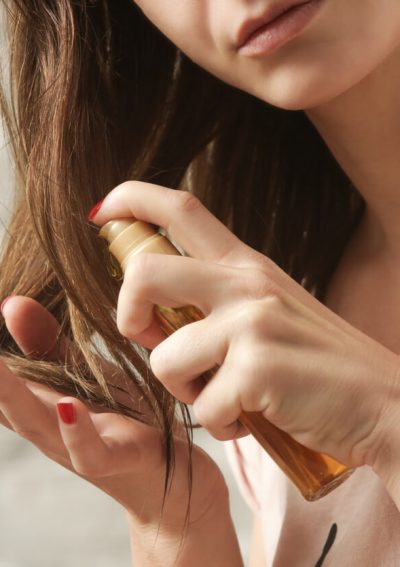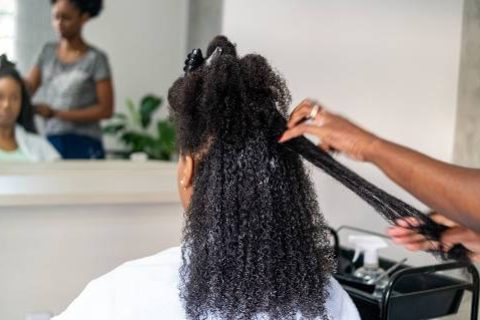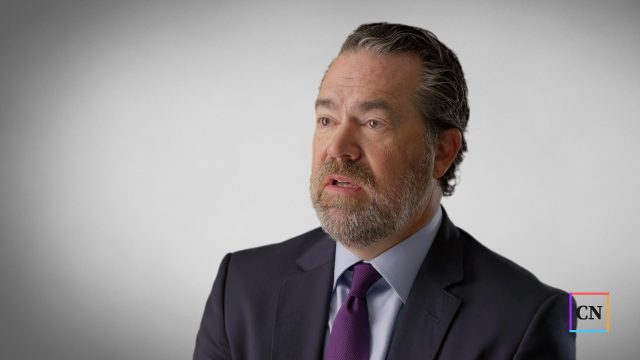Are Chemical Hair Straighteners Safe?
Using chemical hair straighteners may increase the risk of uterine cancer, fibroids, breast cancer and endometriosis, according to studies. Side effects of frequent chemical hair straightener use include weakening of hair, increased frizz, hair discoloration and scalp inflammation.

What Are Chemical Hair Straighteners?
Chemical hair straighteners are lotions or creams that break down the protein structure of curly hair to straighten it permanently. Chemically straightened hair typically stays straight for roughly six months.
Professional stylists administer most chemical hair straighteners at salons because of the potentially harmful chemicals involved. A few kits allow people to chemically straighten their hair at home, but they typically have weaker formulas and might be less effective. Chemical hair straighteners contain harsh chemicals that can damage hair over time and irritate the scalp.
Risks of Chemical Hair Straighteners
According to California’s Department of Toxic Substances Control, hair straighteners contain chemicals like cyclosiloxanes, formaldehyde, parabens, diethanolamine, sodium hydroxide, phthalates, triclosan and benzophenone-3. Some of these substances could harm your health and the environment. According to the Department, they may cause breathing problems, harm development and reproduction, affect hormones and cause skin reactions. In addition, they can stick around in the environment for long periods and may build up in living things.
The U.S. Food and Drug Administration (FDA) has looked at banning formaldehyde in hair relaxers since at least 2016. That’s when the agency began a series of focus groups with salon owners, stylists and consumers about formaldehyde in hair products.
The FDA published a proposed federal rule banning formaldehyde from hair straighteners in spring 2023. The agency then missed the April 2024 deadline it set for itself to put the ban into effect.
Use of hair smoothing products containing [formaldehyde] is linked to short-term adverse health effects, such as sensitization reactions and breathing problems, and long-term adverse health effects, including an increased risk of certain cancers.
In September 2024, the FDA missed another deadline for banning formaldehyde in hair relaxers. The FDA’s latest deadline is March 2025. These delays have left consumers and health advocates concerned about the continued availability of potentially harmful products on the market.
Types of Chemical Hair Straighteners
Types of chemical hair straighteners — sometimes called relaxers — include traditional chemical straightening, Japanese straightening and Brazilian keratin treatments.
Each type of straightening works for different levels of curly hair, from very curly to slightly wavy or frizzy. Stronger chemical treatments work for very curly hair and last longer, but they are more damaging to the hair and scalp.
- Traditional Chemical Straighteners:
- Typically made with sodium hydroxide to permanently straighten hair, these hair relaxers can irritate the scalp and damage hair. Traditional straightening lasts until the hair grows back out.
- Japanese Heat Straighteners:
- Also known as thermal reconditioning, they use ammonium thioglycolate, which can damage the hair. Japanese heat straightening typically lasts for up to six months.
- Brazilian Keratin Straighteners:
- Keratin treatments are temporary and wash out gradually over the course of roughly three months. They smooth hair without breaking protein bonds and some contain formaldehyde. This treatment is primarily for wavy hair.
Experts further classify chemical hair straighteners as lye relaxers, no-lye relaxers and thio relaxers, depending on the product’s ingredients. Permanent lye relaxers have the harshest chemicals and potentially damage hair most long-term.
How Do Chemical Hair Straighteners Work?
Chemical hair straighteners break protein bonds in the hair known as disulfides. Curlier hair has more disulfide bonds. Stronger chemicals are often necessary to break these bonds in curlier hair.
After breaking the bonds, the stylist will apply a neutralizer to reform the disulfide bonds. While reforming the bonds, the stylist will configure the hair into its new shape to straighten it.
Gentler chemical hair straighteners use weaker chemicals to straighten hair, but they don’t last as long and won’t work on very curly hair. Some types of straighteners, such as Japanese or keratin straightening, don’t allow you to wet or wash your hair for at least 48 hours afterward.
Using Chemical Hair Straighteners Safely
The safest way to use chemical straighteners is to have a professional stylist apply them for you. Stylists receive training to properly apply chemicals that can damage your scalp and skin.
“Chemical hair relaxers are corrosive products that are meant to break down the hair protein so that the hair can be smoothed into a permanently straight position,” Ghanima Abdullah, a cosmetologist and beauty consultant at therighthairstyles.com, told Drugwatch. “The same corrosion can affect the hair follicles by breaking down the structures inside the hair follicle, leading to poor hair health and stunted growth.”
If you use a home kit to straighten your hair, follow all instructions and precautions. Set timers to avoid over-processing your hair. You can use petroleum jelly or base oils on your scalp and hairline to prevent skin irritation.
Chemically straightening your hair can cause long-term damage and scalp irritation. Over time, reapplying chemicals over previously straightened hair causes it to weaken and break.
Side Effects of Chemical Hair Straighteners
Chemical hair straightener side effects include short-term problems such as scalp irritation and hair damage, as well as long-term side effects such as an increased risk of endometriosis. Studies have also linked hair straightening products to cancer.
“Recent studies have suggested a possible association between frequent use of chemical hair relaxers and an increased risk of hormone-related cancers, such as breast and uterine cancer,” Dr. Janet Vafae, a board-certified dermatologist in Los Angeles, told Drugwatch. “For instance, a study published in the International Journal of Cancer indicated a higher incidence of breast cancer among women who regularly used hair relaxers.” That 2019 study found that nearly 75% of Black women had used hair straighteners in the previous year.
A study from Boston University’s Black Women’s Health Study released in December 2023 found that postmenopausal Black women who used hair relaxers more than twice a year or for over five years had a more than 50% higher risk of uterine cancer compared to those who rarely or never used them.
A 2022 National Institute of Health study found women who used chemical hair straighteners had a significantly increased risk of uterine cancer compared to women who didn’t use them. Another NIH study in 2019 found women who used chemical hair straighteners had a 30% increase in the incidence of breast cancer. Black women are particularly at risk because they use hair straighteners at higher rates than other consumers.
- Allergic reactions
- Burns
- Damage to the hair shaft
- Eczema
- Frizzy hair
- Hair discoloration
- Hair loss and/or alopecia
- Scalp inflammation
- Scalp irritation and pain
- Skin atrophy
Women who used straighteners and later developed uterine, endometrial and ovarian cancer filed chemical hair straightener lawsuits naming L’Oreal, Dark & Lovely, Namaste and other brands and parent companies as defendants. Plaintiffs said the defendants sold these harmful products even if they knew they could cause cancer and failed to warn the public.
Alternatives to Chemical Hair Straighteners
A popular alternative to chemical hair straightening is heat styling with hair serums made without harsh chemicals. These methods last only a day or two but are safer than chemical straightening.
“We emphasize alternative methods for hair straightening that promote hair health, such as thermal styling and embracing natural textures,” Rachel Voss, a hairstylist and owner of Voss Salon outlets in the Dallas, Texas area, told Drugwatch. “These techniques avoid harsh chemicals and support long-term scalp and hair wellness.”
Heat styling can also damage hair but doesn’t carry a risk of cancer or other reproductive system issues. To reduce damage from heat styling, use a heat protectant on your hair, use the right temperature for your hair type and condition the hair after styling.
Several online recipes for natural hair straighteners made with coconut milk, fruits or oils promise effective straightening. However, these methods might not be reliable.
14 Cited Research Articles
Consumernotice.org adheres to the highest ethical standards for content production and references only credible sources of information, including government reports, interviews with experts, highly regarded nonprofit organizations, peer-reviewed journals, court records and academic organizations. You can learn more about our dedication to relevance, accuracy and transparency by reading our editorial policy.
- Bertrand, K.A., et al. (2023, December 15). Hair Relaxer Use and Risk of Uterine Cancer in the Black Women's Health Study. Retrieved from https://www.sciencedirect.com/science/article/abs/pii/S0013935123020327
- Boston University Chobanian & Avedisian School of Medicine. (2023, October 11). First Large Study of Hair Relaxers Among Black Women Finds Increased Risk of Uterine Cancer. Retrieved from https://www.bumc.bu.edu/camed/2023/10/11/first-large-study-of-hair-relaxers-among-black-women-finds-increased-risk-of-uterine-cancer/
- Chang, C-J et al. (2022, December 8). Use of Straighteners and Other Hair Products and Incident Uterine Cancer. Retrieved from https://pubmed.ncbi.nlm.nih.gov/36245087/
- United States Judicial Panel on Multidistrict Litigation. (2022, November 15). Memorandum in Support of Plaintiffs’ Motion for Transfer of Actions Pursuant to 28 U.S.C. § 1407 for Coordinated or Consolidated Pretrial Proceedings. Retrieved from https://www.aboutlawsuits.com/wp-content/uploads/2022-11-15-MDL-Motion.pdf
- Samuelson, K. (2022, November 14). Uterine Fibroid Growth Activated by Chemicals Found in Everyday Products. Retrieved from https://news.northwestern.edu/stories/2022/11/uterine-fibroid-growth-activated-by-chemicals-found-in-everyday-products/
- Howard, J. (2022, October 24). US Woman Files Lawsuit Against L’Oréal, Claiming Chemical Hair Straightening Products Are Linked to Her Cancer. Retrieved from https://www.cnn.com/2022/10/24/health/hair-straightening-products-lawsuit
- Adams, C. (2022, October 17). Chemical Hair Straighteners Linked to Higher Risk of Uterine Cancer for Black Women, Study Shows. Retrieved from https://www.yahoo.com/video/chemical-hair-straighteners-linked-higher-234101030.html
- L’Oreal. (2022, July 27). Everything You Should Know Before Getting a Hair Relaxer. Retrieved from https://www.lorealparisusa.com/beauty-magazine/hair-care/all-hair-types/relaxed-hair
- de Paula, J.N.H. et al. (2022, March 11). Effects of Chemical Straighteners on the Hair Shaft and Scalp. Retrieved from https://www.sciencedirect.com/science/article/pii/S0365059621003147
- National Institutes of Health. (2019, December 4). Permanent Hair Dye and Straighteners May Increase Breast Cancer Risk. Retrieved from https://www.nih.gov/news-events/news-releases/permanent-hair-dye-straighteners-may-increase-breast-cancer-risk
- Eberle, C.E., et al. (2019, December 3). Hair Dye and Chemical Straightener Use and Breast Cancer Risk in a Large US Population of Black and White Women. Retrieved from https://onlinelibrary.wiley.com/doi/abs/10.1002/ijc.32738
- Nazir, S. et al. (2018). Women Diagnosed with Endometriosis Show High Serum Levels of Diethyl Hexyl Phthalate. Retrieved from https://www.ncbi.nlm.nih.gov/pmc/articles/PMC6094529/
- California Department of Toxic Substances Control. (n.d.). Chemicals in Hair Straightening Products. Retrieved from https://dtsc.ca.gov/scp/chemicals-in-hair-straightening-products/
- Pantene. (n.d.). Straight Talk. Retrieved from https://www.pantene.com.au/en-au/brandexperience/straight-talk
Calling this number connects you with a Consumer Notice, LLC representative. We will direct you to one of our trusted legal partners for a free case review.
Consumer Notice, LLC's trusted legal partners support the organization's mission to keep people safe from dangerous drugs and medical devices. For more information, visit our partners page.
866-461-6220



